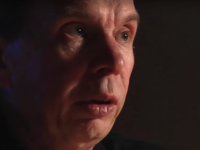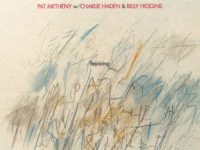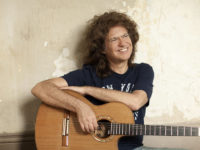With this album, we have what many think of as the classic Pat Metheny Group sound, “San Lorenzo” being a perfect exemplar.
My first instinct is to say that the music has a lot of space in it, but that doesn’t quite get us there. It’s more that the musical structures are built by implication. Listen to how the changes are danced around with chiming artificial harmonics, short bass missives, attackless guitar tones, and Lyle Mays’ swipes across the autoharp. These sequences are often punctuated by a quick volume increase, accented by Dan Gottlieb’s cymbal washes. The group’s use of dynamics in this way is definitely one of their defining characteristics, with many examples to follow.
The live version actually lacks some of sonic detail of the studio track, but I just couldn’t resist the odd charm of seeing Pat playing that electric 12-string.
- Why the Rolling Stones’ Harrowing ‘Gimme Shelter’ is Still Revealing New Depths - November 18, 2024
- How Talking Heads’ ‘Fear of Music’ Opened Up a World of Art and Sound - August 5, 2024
- How Deep Cuts Propelled Bruce Springsteen’s ‘Born in the U.S.A.’ - June 4, 2024





Well, forgive me if I gush, this is what I’ve been waiting for… This is where it REALLY begins. With Mark Egan in place on the bass, to me, and as Mark had mentioned, this is the unequivocal sound of the Pat Metheny Group. With those five opening note pairs on an “oddly tuned 12 string electric”, in Pat’s own words, my future would never be the same. This is the still unrecognized revolution that these four guys launched.
First, let’s talk instruments, and their not-so-traditional use. You have Pat playing an alternately tuned electric 12-string guitar. This is another “don’t try this at home” tuning. Something of the pentatonic, 5th-y variety, to paraphrase. In the embryonic days of the Group, we was using a wildly sub-standard Fender Coronado for this piece, which I’m sure had stability and tuning issues. He got better grounded with a Guild model, and eventually the beautiful (strike that, gorgeous) Ibanez Artist model that is proudly featured as part of the ‘Travels’ LP gatefold. For live performances, as far as I know, Pat did not swap with any other guitars during this extended piece, as was the hallmark of next week’s tune.
In Lyle’s court, you have, in my opinion, the introduction of his use of the Oberheim synthesizer. This synth would become signature Lyle Mays for years. His use of the Oberheim is directly intertwined with the “Group” sound, without a doubt. So many great PMG moments are the combination of a melodic Lyle line on the Oberheim with some form of ringing, arpeggiated, note(s) from Pat. As if that introduction wasn’t enough, you also have Lyle adding Autoharp sweeps to punch in some rhythm and additional texture. I always thought these ringing “sweeps” where Pat nailing some kind of harmonics, but once I saw video footage, I realized it was Lyle and an Autoharp!
The composition of the tune has a modular feel, but that is not to even hint at the idea that the song doesn’t work on the sum of these parts. In turn, you have the lead melody being covered by Lyle at times, then by Mark on fretless bass, and some of the straightest, purest doses of Pat Metheny arpeggios you will ever hear. I warned you about the gushing… You get rubato tempos, quickly turned around by slightly Latin-ized offbeat grooves. Danny Gottlieb adding perfect punches and full rock-scale drum fills. Then, the return of that perfect, four chord arpeggiated part. It just rings. Queue up the Oberheim again. I swear I will never tire of this music.
A great juxtaposition of ‘San Lorenzo’, at least in the realm of being associated with Pat Metheny, is that there is no guitar solo, at least in the sense of the blowing jazz tradition. The guts of this tune center around the brilliance of Lyle Mays, and the acoustic piano. This is vintage Lyle. Slide the synths and the Autoharp over. Built around a pedal point approach, with minimal (basically, starting in silence) tonal and rhythmic support from the band. Close your eyes, and listen to this one build. Get the ‘Travels’ version, scour the Internet, get your hands on live copies of this tune, circa 1979 through 1985. You will hear dynamics and musical builds that would make jam bands weep. For Phish fans, there is a “no doubt about it” similarity to the building jam of “Reba” that exists here. Lyle drives this one all the way. For me, this is some his finest moments ever, and it is basically in the framework of a trio, sitting on a one chord vamp.
The final climax has a prolonged line, walking down the other side of the mountain, leaving it open, once again. The song could be rightfully over at this point, but he coaxes a few last notes to queue up the mid-melody line once again. As he repeats it, the band joins in and picks up steam, culminating in Gottlieb officially popping it into gear. Pat joins in the climbing, unison line…and it builds, here we go. And then Eureka, a single, very high, synth notes rings over the aforementioned perfect four chords. Egan loops the fretless melody, even higher on the neck this time. The rhythm disintegrates as the perfect arpeggio busts at the seams in de-evolution. Lastly, Lyle walks, finger by finger, up the keys to land the perfect trill…let it ring.
Pat queues the closing right where they started. A restating of the oddly tuned five opening note pairs all by himself, and the whole band joins in for the grand closing sweep (crank up that Autoharp!).
Landmark innovation in instrument tuning and usage, composition, and arranging, not to mention the insanely original voicing between Pat and Lyle. The still unrecognized revolution.